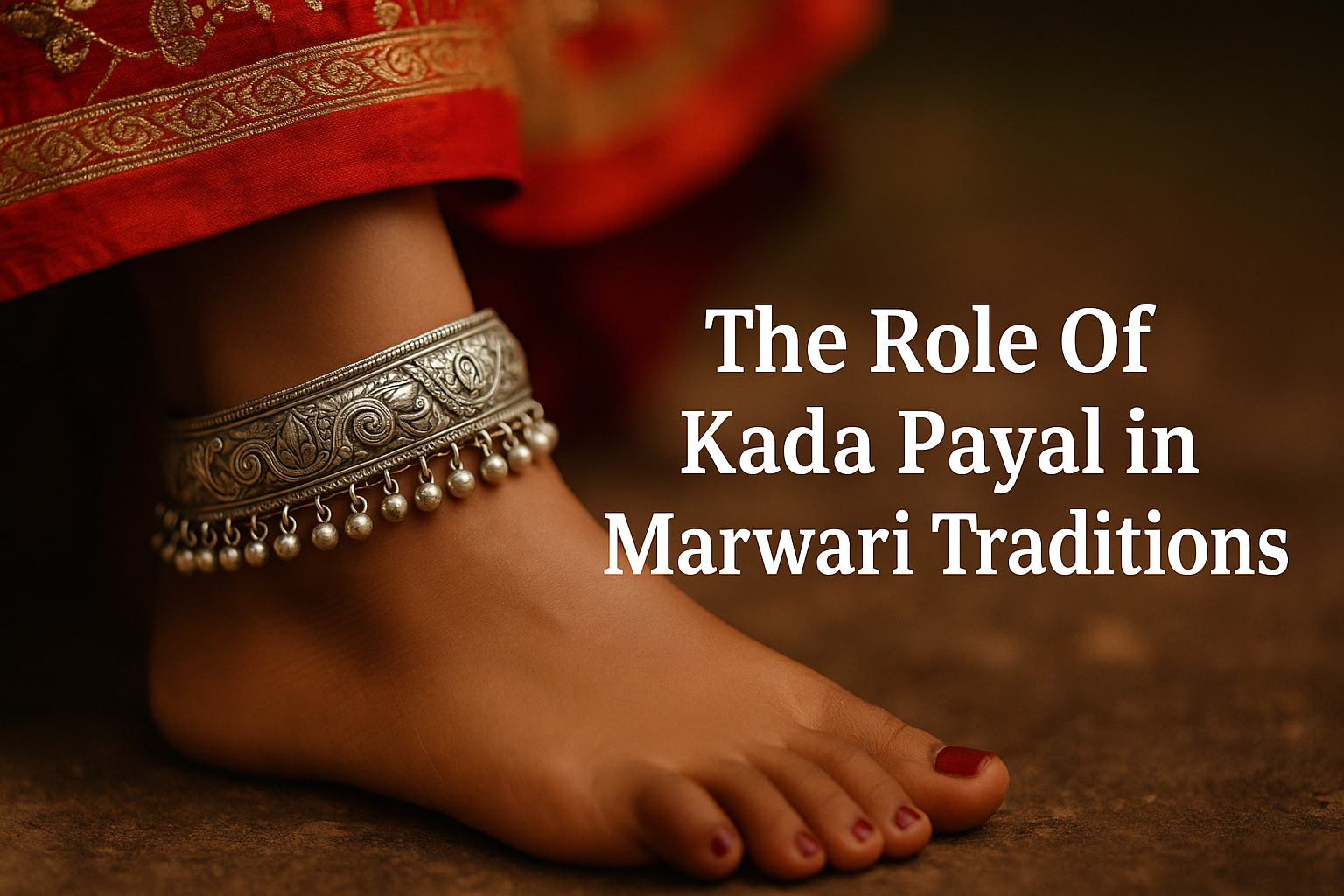
The Role Of Kada Payal in Marwari Traditions
Published on July 30, 2025
In the vibrant tapestry of Marwari culture, jewelry holds a deeply rooted significance—both as a symbol of heritage and as a vessel of emotion and identity. Among the many treasured adornments, the Kada Payal, a thick silver anklet often crafted with ornate detailing and small hanging bells, has long been a prominent piece worn by Marwari women, especially during rituals, weddings, and festivals.
The Historical Significance of Kada Payal in Marwari Culture
Historically, the Kada Payal is not merely a decorative piece; it symbolizes the boldness, pride, and elegance of a Marwari woman. Traditionally worn after marriage, it marks the entry of the woman into a new chapter in life. Royal Marwari families had silver Kada Payals specially crafted for brides, at times with symbolic motifs such as peacocks, lotuses, or sunbursts—each symbolizing prosperity, purity, and energy.
Made largely of pure silver, a metal in Hindu lore famous for cooling and cleansing properties, Kada Payals were thought to also excite the blood and soothe arthritic joints—an illustration of how traditional ornaments were blended with concepts of health. This practice of presenting payals to daughters and daughters-in-law at pivotal times of their lives is followed by many Marwari families even today.
In addition, the rhythmic clinking of bells that hang on the Kada Payal is purported to be representative of feminine elegance. In ancient Marwari homes, the euphonic sounds announced the arrival of a woman, infusing the dwelling with auspicious energy. Even in folk melodies and traditional Rajasthani dances, the symbol of a woman's payal resonates with imagery of beauty, romance, and divine duty.
With the Kada Payal, the women of Marwari not only pass on silver anklets, but centuries-old heritage, mythology, and generations-old blessings incorporated in every twisted detail and clink.
Materials Used in Making Kada Payal in Marwari Culture
The traditional Kada Payal holds deep cultural value in Marwari heritage, and the materials used in crafting them reflect both symbolic and practical choices. Each element carries its own meaning, function, and place in Marwari customs. Below are the primary materials used-
1. Silver (Most Common and Traditional)
Silver is the most popular metal used for Marwari Kada Payals. Silver is said to represent purity, femininity, and spiritual power. Silver also possesses cooling properties in the beliefs of old and is said to enhance blood circulation when worn on the feet. Thicker silver kada payals are made by hand with bells or etched designs and are usually passed down as family heirlooms among Marwaris.
2. Gold
While less popular than silver in anklets, gold is occasionally employed in bridal kada payals as a symbol of prosperity, status, and good fortune. It finds greater usage among royal or wealthy families. Gold ornaments or trimmings are occasionally attached to silver platforms for a more luxurious look on important occasions.
3. Brass
Brass provides a cheaper option to silver and gold while retaining a historical look. Brass is long lasting and frequently employed in rural or casual wear kada payals. Such payals can have plain designs or replicate the pattern of silver at lower expense, thus making it available to more people.
4. Gemstones
The gemstones of turquoise, coral, garnet, or onyx are sometimes inlaid in kada payals for aesthetic as well as religious purposes. Each gemstone is thought to imbue specific energies—such as protection, prosperity, or emotional stability—giving greater significance to the ornament, particularly in bridal jewelry.
5. Fabric and Thread Work
In more traditional or folk-inspired versions, threads of fabric are incorporated into the metal structure or provide the foundation for light anklets. These are flexible, brightly colored, and occasionally decorated with small bells or charms. They are favoured during performances and celebrations.
6. Beads and Glass Work
Colorful beads, glass inlays, and enamel motifs are employed to beautify the design, particularly in Rajasthani artisan handicraft. Although not part of core Marwari ceremonies, these motifs find appreciation now in contemporary forms for their color and artistic value.
Connection of Kada Payal with Different Marwari Rituals
In Marwari culture, the Kada Payal is not merely a piece of jewelry—it holds sacred value and plays a meaningful role in many important rituals and life events. Its presence is woven into the cultural fabric of ceremonies that mark transitions, blessings, and celebration.
1. Wedding Ceremonies
The most important association of Kada Payal is with Marwari weddings. During the Solah Shringar ceremony, a bride is dressed in sixteen traditional adornments, and silver payals are an important part of this set. The heavy kada-style payals represent the blessings of the family, protection against evil, and entry of the bride into a new life with prosperity. They are usually presented by the mother-in-law as a welcome gift.
2. Godbharai (Baby Shower)
During Godbharai or baby shower, married women adorn their best jewelry, including their kada payals, as a blessing sign for the mother-to-be. The musical jingling of the payals is said to impart joy and positivity, thus making them a lucky accessory during the occasion.
3. Teej and Gangaur Festivals
During festivals such as Teej and Gangaur, honouring marital happiness and the health of the husband, women adorn themselves beautifully and dance traditional dances. Kada payals, usually accompanied by ghunghroos, are also worn for their role in making their footwork more gracious. The sweet sound that they make becomes part of the festive beat.
4. Post-Marriage Rituals
Even post-wedding, the Kada Payal remains on throughout several family and temple customs. It is a symbol of ongoing marital commitment, womanhood, and cultural values that the bride now brings to her new home.
Hence, Kada Payals are closely associated with Marwari ceremonies, representing tradition, safety, loveliness, and religious connectivity in all major milestones of life.
Kada Payal in Modern Marwari Homes
In contemporary Marwari households, the Kada Payal still occupies an honoured position, albeit with a new role in accordance with new lifestyles and fashion consciousness. As much as the traditional heavy silver anklets are still prized, modern adaptations today blend the past with minimalism.
Most Marwari young women like lighter, slimmer versions of the Kada Payal that one can wear every day. The new designs share the spirit of classic motifs—such as peacocks, floral engravings, or ghunghroos—but with contemporary work and comfort. They are usually worn with both ethnic and Indo-western garments so they are functional accessories as opposed to ceremonial ones.
In spite of modernization, Kada Payals remain a necessary part of Marwari bridal trousseaux. Special order sets are made for weddings, baby showers, and festivals, and mothers still hand down heirloom payals as tokens of love and tradition.
Some parents also choose gold-plated or gem-studded ones to keep up with more modern fashion trends while maintaining cultural meaning.
In city households too, payals are worn as celebratory fashion items on festivals such as Karwa Chauth, Navratri, or at family reunions. Handcrafted kada payals are making a comeback, since people are increasingly appreciating handcrafted silver jewelry with cultural heritage.
In the end, in today's Marwari households, the Kada Payal is more than tradition—it's a celebration of self. Whether kept in its original form or transformed to suit modern tastes, it still symbolizes elegance, heritage, and the ageless beauty of Marwari womanhood.
Conclusion
The Kada Payal is much more than merely an ornament in Marwari tradition—much more a symbol of heritage, identity, and ageless beauty. From its origin in royal families to its persistence even today in homes, it has adapted itself with dignity without losing its cultural essence. Be it on occasions of weddings, festivals, or daily use, the Kada Payal symbolizes a woman's life, fortitude, and poise. Made out of silver, gold, or studded with stones and beads, every pair has tales conveyed through generations. In the contemporary world where conventions have to harmonize with modern tastes, the Kada Payal still acts as a linkage between the past and the present. For Marwari women, it is not only a decoration but a valuable heirloom, a religious symbol, and a tribute to their tradition. With fashion and culture becoming more and more entwined, the Kada Payal is an exemplary case of how tradition and beauty can go hand in hand.
